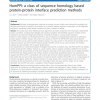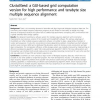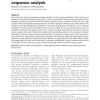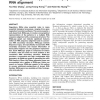372 search results - page 35 / 75 » Fast Protein Structure Alignment |
BMCBI
2008
13 years 7 months ago
2008
Background: A multiple sequence alignment (MSA) generated for a protein can be used to characterise residues by means of a statistical analysis of single columns. In addition to t...
BMCBI
2011
12 years 11 months ago
2011
Background: Although homology-based methods are among the most widely used methods for predicting the structure and function of proteins, the question as to whether interface sequ...
BMCBI
2010
13 years 7 months ago
2010
Background: There is an increasing demand to assemble and align large-scale biological sequence data sets. The commonly used multiple sequence alignment programs are still limited...
BIB
2006
13 years 7 months ago
2006
One of the major goals of computational sequence analysis is to find sequence similarities, which could serve as evidence of structural and functional conservation, as well as of ...
NAR
2008
13 years 6 months ago
2008
Regulatory RNAs play essential roles in many essential biological processes, ranging from gene regulation to protein synthesis. This work presents a web-based tool, RNALogo, to cr...




